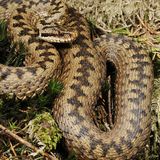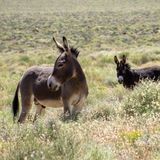RECENT ARTICLES

A viper's zig-zag colors help blur their predators' vision
Evolutionary biologists are constantly trying to make sense of patterns in nature — from the global-scale patterns of biological diversity to the individual color patterns on an animal’s fur. Prey animals are especially interesting puzzles because of their unique adaptations that help them avoid being eaten. Some evolve extreme camouflage, like and bottom-dwelling fish. Others which they use as chemical defenses against predators. Toxic or venomous prey often advertise their defenses using (think wasps, butterflies, and poison frogs). Now, scientists are seeing that venomous snakes can have...…Evolutionary biologists are constantly trying to make sense of patterns in nature — from the global-scale patterns of biological diversity to the individual color patterns on an animal’s fur. Prey animals are especially interesting puzzles because of their unique adaptations that help them avoid being eaten. Some evolve extreme camouflage, like and bottom-dwelling fish. Others which they use as chemical defenses against predators. Toxic or venomous prey often advertise their defenses using (think wasps, butterflies, and poison frogs). Now, scientists are seeing that venomous snakes can have...WW…

Cougars Are Killing Feral Donkeys, and That’s Good for Wetlands
In the Mojave and Sonoran deserts of North America, donkeys roam wild. Also called burros, feral donkeys travel in herds, seeking out water sources in small wetland oases, often trampling vegetation in the process. These critical wetlands include that many animals rely on to survive in the otherwise bone-dry desert environment.The National Park Service considers the donkeys an , and many conservationists advocate for killing or relocating them as they are assumed to lack predators that could keep their populations in check. But in a recent study, a team of ecologists found that these...…In the Mojave and Sonoran deserts of North America, donkeys roam wild. Also called burros, feral donkeys travel in herds, seeking out water sources in small wetland oases, often trampling vegetation in the process. These critical wetlands include that many animals rely on to survive in the otherwise bone-dry desert environment.The National Park Service considers the donkeys an , and many conservationists advocate for killing or relocating them as they are assumed to lack predators that could keep their populations in check. But in a recent study, a team of ecologists found that these...WW…

The DNA of Hundreds of Insect Species Is in Your Tea
If the leaves from a tea bag could tell their stories, they would paint a picture of a thousand fleeting interactions. Bees landed on them while pollinating flowers. Caterpillars chewed on them and built cocoons near them. Spiders tethered webs to them.But many of the relationships between plants and animals go undocumented. Cataloging every animal that feeds on or pollinates a given plant can take a massive amount of time and effort. “There's very, very specific interactions, and very cryptic interactions of which we know very little because no one has basically put in the effort of...…If the leaves from a tea bag could tell their stories, they would paint a picture of a thousand fleeting interactions. Bees landed on them while pollinating flowers. Caterpillars chewed on them and built cocoons near them. Spiders tethered webs to them.But many of the relationships between plants and animals go undocumented. Cataloging every animal that feeds on or pollinates a given plant can take a massive amount of time and effort. “There's very, very specific interactions, and very cryptic interactions of which we know very little because no one has basically put in the effort of...WW…
- Total 3 items
- 1